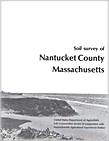The following map unit description is from the published "Soil Survey of Nantucket County, Massachusetts"

Soil Survey of
Nantucket County Massachusetts
The following map unit description is from the
published "Soil Survey of Nantucket County, Massachusetts"

WaA-Woodbridge Variant loam, 0 to 3 percent slopes. This moderately well drained soil is in nearly level areas and shallow depressions. Areas are irregular in shape and range from 3 to 50 acres.
Typically, the surface layer is dark brown loam about 9 inches thick. The subsoil is 28 inches thick. In sequence downward, it is 4 inches of brown, friable loam; 5 inches of light olive brown, friable sandy clay loam; 7 inches of brown, mottled, firm clay loam; and 12 inches of strong brown, mottled, firm loam. The substratum extends to a depth of 60 inches or more. It is strong brown, mottled very fine sandy loam in the upper part and light olive brown, mottled silty clay loam in the lower part.
Included with this soil in mapping are a few areas of soils that have more gray in the subsoil than this Woodbridge Variant soil and a few areas of soils that have mottles in the upper part of the subsoil. Included soils make up about 15 percent of the unit.
The permeability of this soil is moderate in the upper part of the subsoil and very slow in the lower part of the subsoil and in the substratum. Available water capacity is high. The soil has a seasonal high water table at a depth of 1.5 to 2.5 feet in winter and spring. The seasonal high water table restricts root growth in spring.
Most areas of this soil are covered with woody vegetation. The soil is suitable for openland wildlife habitat and woodland wildlife habitat. It is poorly suited to most other nonfarm uses.
This soil is well suited to crops, hay, and pasture. Wetness is the main limitation of the soil for these uses. Surface drainage, diversions, tile drainage, or a combination of these practices helps remove water from the soil. Overgrazing or grazing when the soil is wet causes compaction of the surface layer and reduces the hardiness and density of plants.
The seasonal high water table and a high frost action potential limit this soil for use as building sites. Areas used for dwellings need to be drained, and foundations need special design to prevent structural damage caused by frost action. The high frost action potential also limits the use of the soil for roads and streets. Replacing the upper layer of the soil with a suitable base material helps prevent damage caused by frost action. The use of the soil for septic tank absorption fields is limited by the seasonal high water table and by the very slow permeability in the lower part of the soil. Capability subclass IIw.
WaB-Woodbridge Variant loam, 3 to 8 percent slopes. This gently sloping moderately well drained soil is on convex slopes. Areas are irregular in shape and range from 3 to 75 acres.
Typically, the surface layer is dark brown loam about 9 inches thick. The subsoil is 28 inches thick. In sequence downward, it is 4 inches of brown, friable loam; 5 inches of light olive brown, friable sandy clay loam; 7 inches of brown, mottled, firm clay loam; and 12 inches of strong brown, mottled, firm loam. The substratum extends to a depth of 60 inches or more. It is strong brown, mottled very fine sandy loam in the upper part and light olive brown, mottled silty clay loam in the lower part.
Included with this soil in mapping are a few areas that have more gray in the subsoil than this Woodbridge Variant soil and a few areas of soils that have mottles in the upper part of the subsoil. Included soils make up about 15 percent of the unit.
The permeability of this soil is moderate in the upper part of the subsoil and very slow in the lower part of the subsoil and in the substratum. Available water capacity is high. The soil has a seasonal high water table at a depth of 1.5 to 2.5 feet in winter and spring. The seasonal high water table restricts root growth in spring.
Most areas of this soil are covered with woody vegetation. The soil is suitable for openiand wildlife habitat and woodland wildlife habitat. It is poorly suited to most other nonfarm uses.
This soil is well suited to crops, hay, and pasture. Wetness is the main limitation, and erosion is a hazard for these uses. Surface drainage, diversions, tile drainage, or a combination of these practices helps remove water from the soil. Overgrazing or grazing when the soil is wet causes compaction of the surface layer and reduces the hardiness and density of plants.
The seasonal high water table and a high frost action potential limit this soil for use as building sites. Areas used for dwellings need to be drained, and foundations need special design to prevent structural damage caused by frost action. The use of the soil for roads and streets is limited by the frost action potential. Replacing the upper layer of the soil with a suitable base material helps prevent damage caused by frost action. The use of this soil for septic tank absorption fields is limited by the seasonal high water table and by the very slow permeability in the lower part of the soil.
Capability subclass IIw.